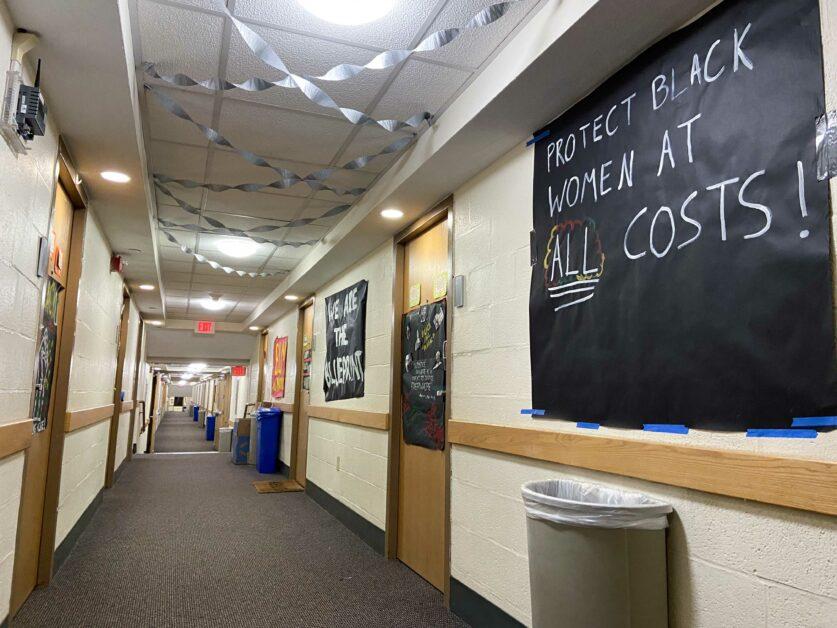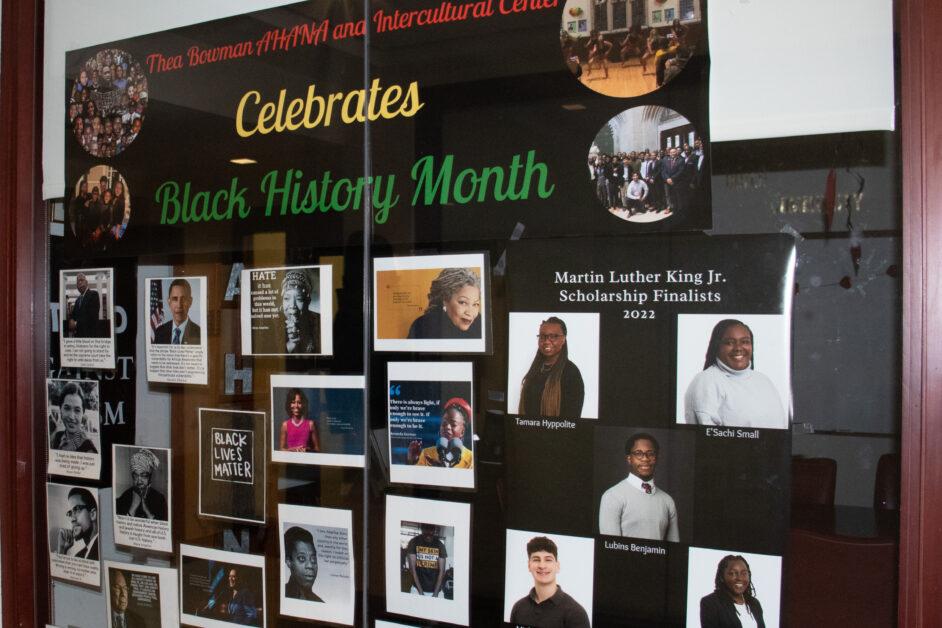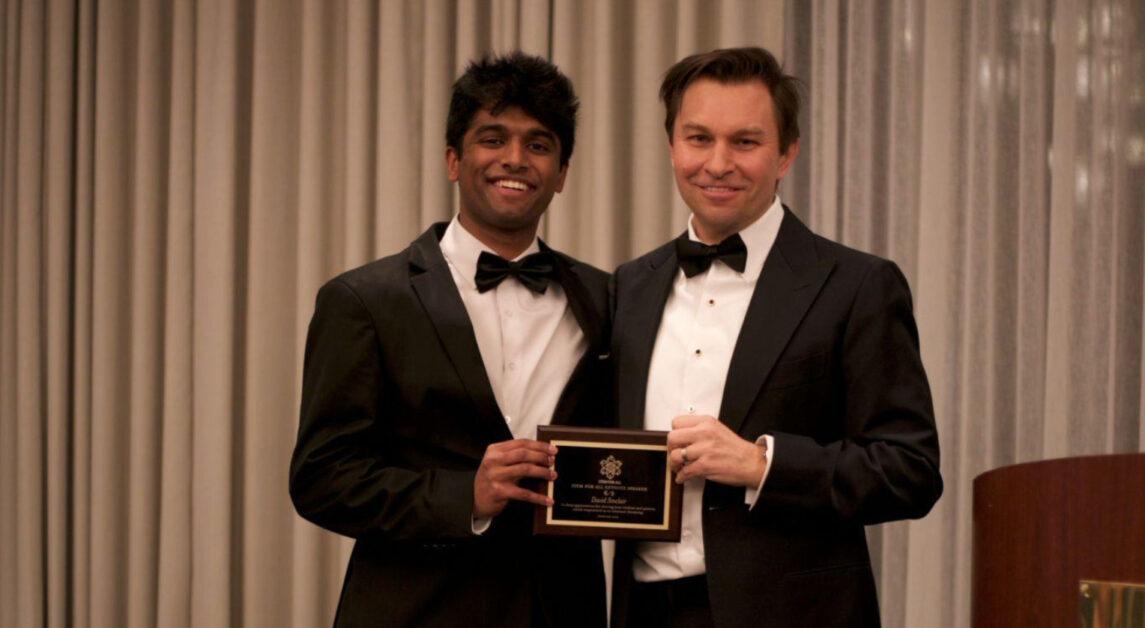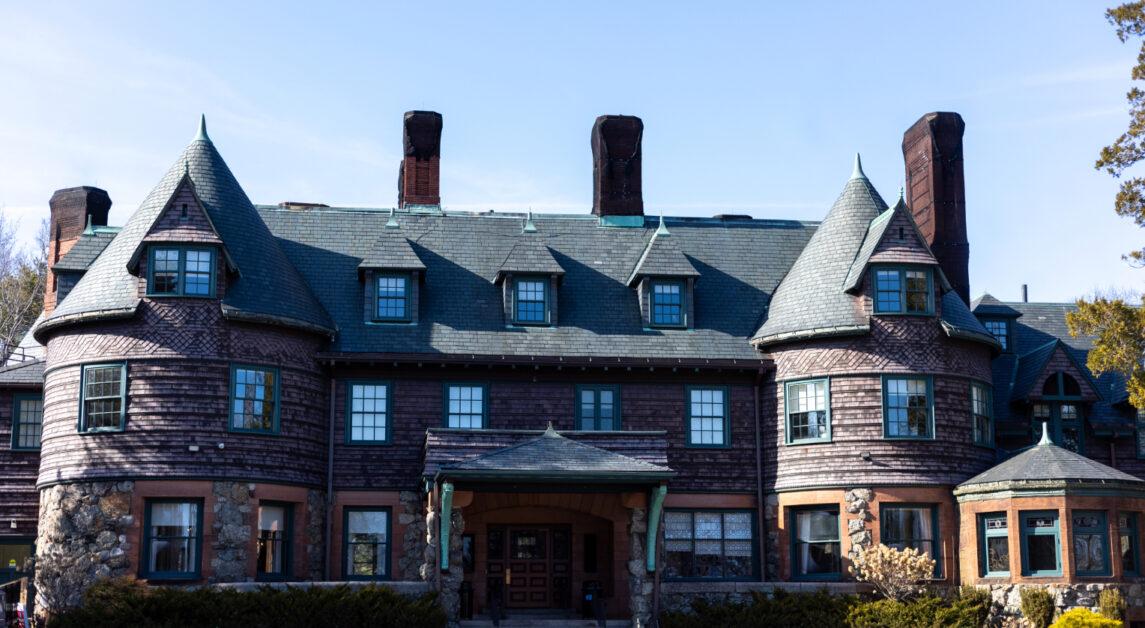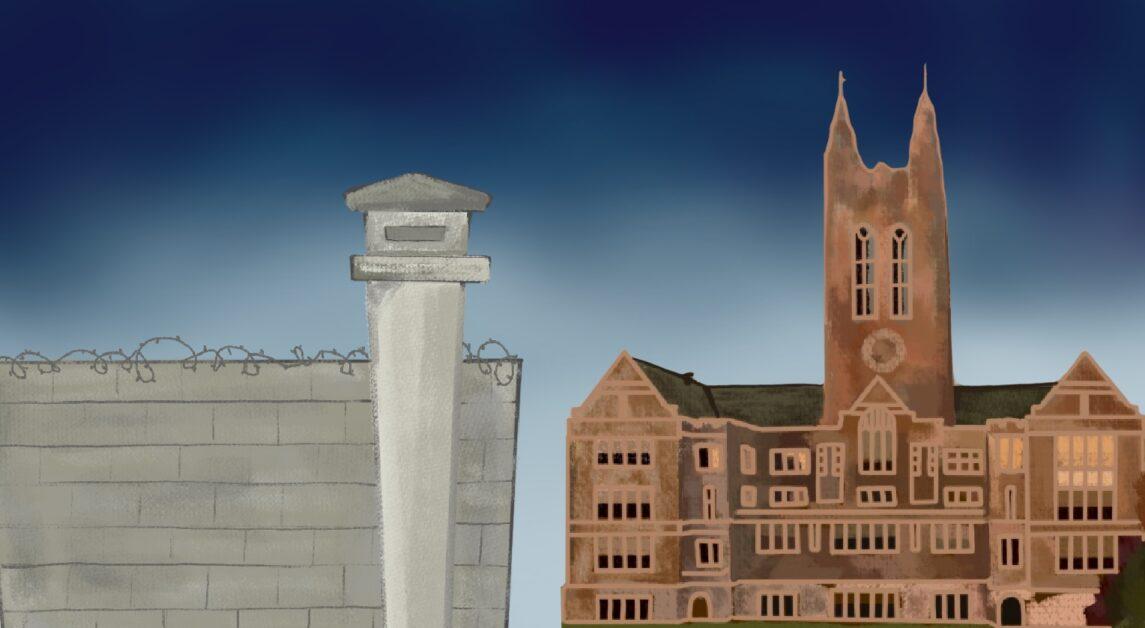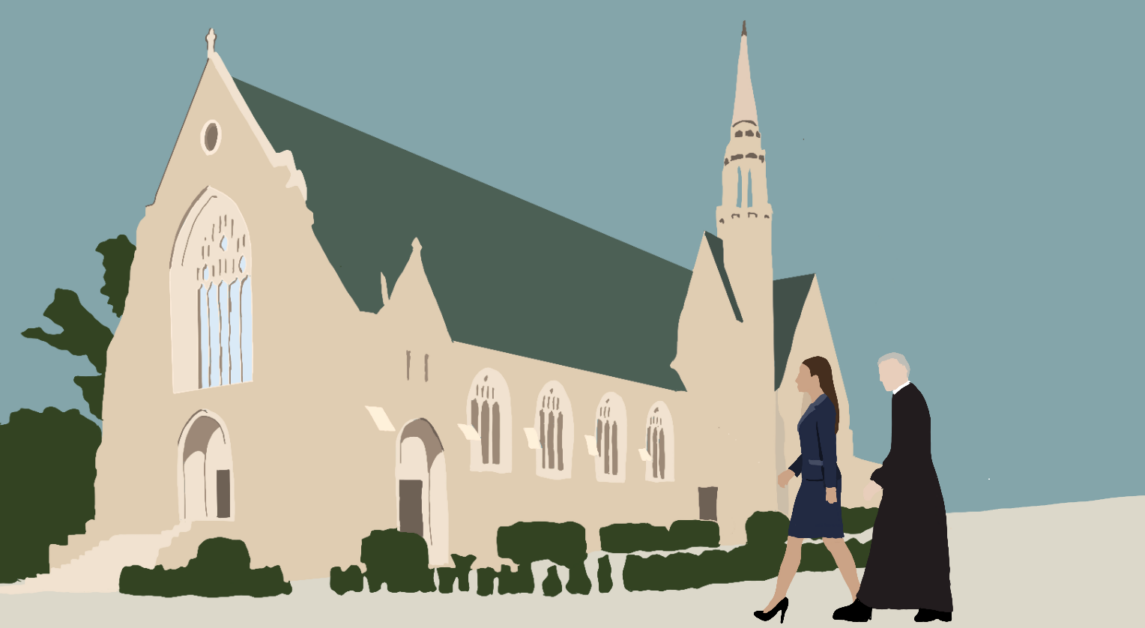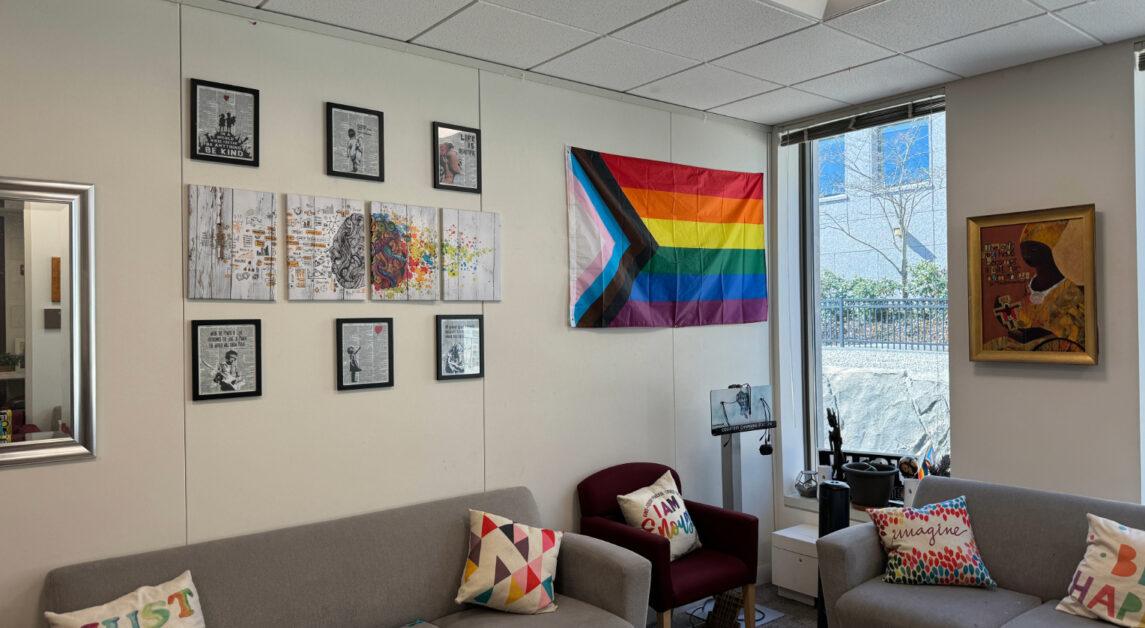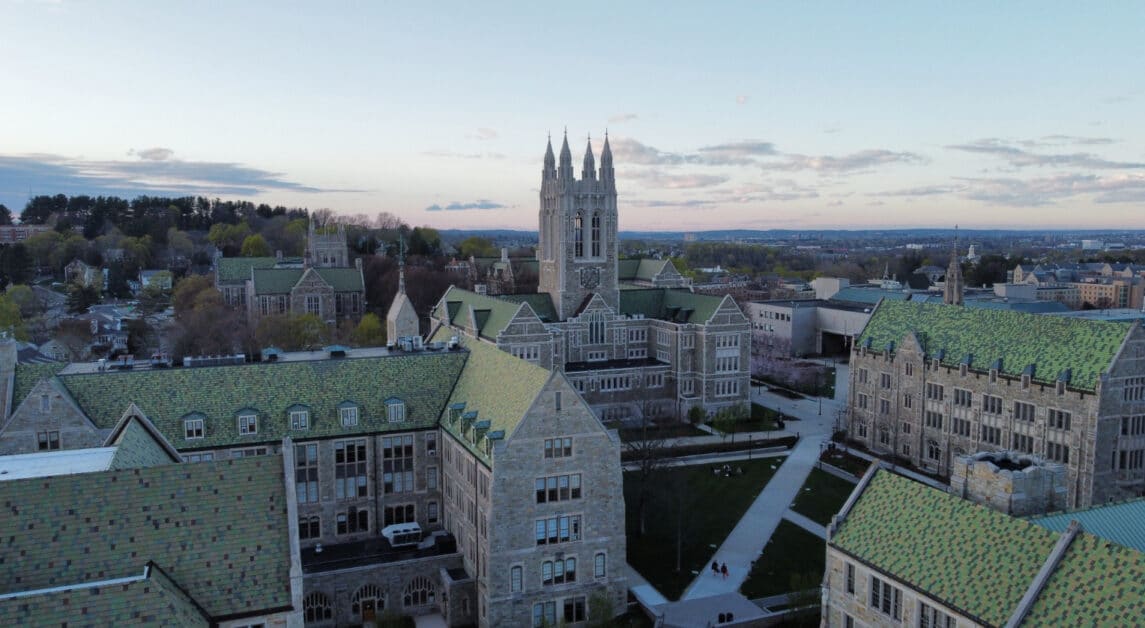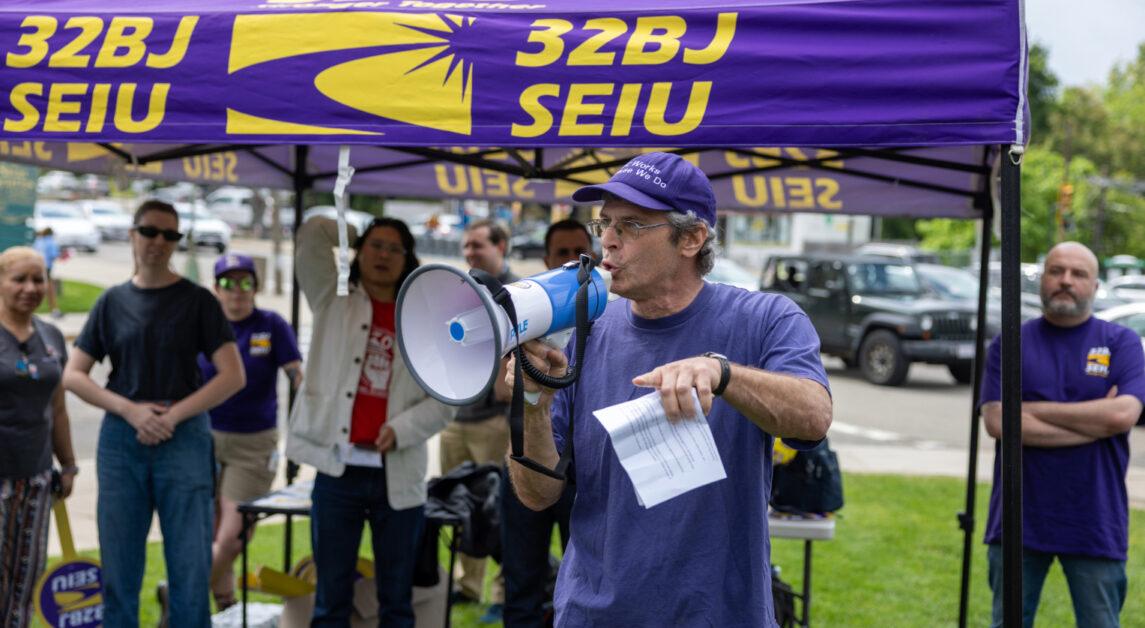Destiny Gonzalez still remembers watching her hallmates knock on doors on the third floor of Loyola Hall in early February of last year. The residents were searching for two boys who had walked across the adjacent Xavier Hall chanting a song about “colored girls.”
“I don’t know their names, but I know their faces,” said Gonzalez, a resident of the Multicultural Learning Experience (MLE) floor last year and MCAS ’24.
At the beginning of the 2021 spring semester, MLE residents reported an incident of racist vandalism that included knocked over trash cans, torn off door decorations, and aggressive knocking on their doors. MLE residents, however, said this was not an isolated incident, describing a pattern of racial harassment targeting the third floor of Xavier Hall on Upper Campus.
One year later, MLE residents are still grappling with the lasting effects of the harassment and the University’s response to the incidents.
“It makes me really uncomfortable because it doesn’t seem right for people like that to be here and around us when they directly are trying to make other people’s lives uncomfortable or unbearable,” Gonzalez said.
Ayanna Rowe, another resident of last year’s MLE and MCAS ’24, said that in the days following the incidents, she was worried about another possible attack on their floor.
“I was kind of just holding my breath, hoping that another attack wouldn’t happen,” Rowe said. “Because it was just like, you know … everybody on campus knew about it, so I was like, ‘I hope it doesn’t invite more [attacks].’”
Isiaah Clark, a Thea Bowman AHANA and Intercultural Center (BAIC) ambassador and MCAS ’24, was a resident of the men’s MLE on the fourth floor of Xavier Hall last year. Clark said he heard about the incidents through his roommates.
Their initial response, he said, was anger.
“We couldn’t fully understand why something like this would happen,” Clark said. “But then also we were angry because of the response time of the BC administration to actually step in and handle these situations.”
At first, Gonzalez said it was difficult to equate the incidents to racially motivated harassment, rather than the behavior of drunk college boys.
“At first, it started very early in the semester, like you get really loud door knocks in the middle of the night, waking you up and like you just think ‘Oh my gosh, like just stupid college boys,’” Gonzalez said. “And then it kept happening every weekend on the same doors. And then people were throwing over our trash cans. And then everything just continued to escalate and then you start to think to yourself, you’re like, ‘Wait, this is a race thing, like this is racially motivated.’”
After the incidents occurred, Gonzalez felt on edge and unsafe in her own dorm, she said.
“[I was thinking], ‘I’m kind of scared to go to sleep at night or like, I have to be on edge,’” Gonzalez said. “‘I have to make sure that no one’s going to attack me or attack my home or I don’t feel safe in my own living space.’ Like that was a lot to digest at the time.”
One student, who spoke under the condition of anonymity, said the incident deeply disturbed them.
“Everyone should always feel comfortable in their own skin, in their own space,” the student said. “So for them to experience something where somebody comes into their space and then violates that and makes them feel in danger or unsafe, was deeply disturbing, especially since I lived on that same hallway my freshman year, and I know those girls. I know them by name, so that was so hard.”
The anonymous student said that they did their best to advocate for the girls on the MLE through their role in the Office of Residential Life.
“In my RA role, I challenged my staff around me and said, ‘What can we do as leaders in ResLife? What can we say to our fellow students and peers and, you know, other RAs? What can we say or do actively?’” the student said. “I was there as a friend to them. I took off my hat as RA, I took off my hat as ambassador or leader in any sense, and I just stood by those girls.”
Osa Owens, CSOM ’24, lived on the men’s MLE floor when the incidents occurred last year and recalls the anxiety and anger that he and his floormates felt as a result.
“I was very upset with the situation,” Owens said. “I was even more upset with BC’s response to it. Nothing really substantial happened.”
One way the University attempted to reconcile the situation was by holding Zoom meetings with the MLE residents to discuss what happened, he said.
“We were not the ones who committed the vandalism, so I don’t know why they were taking time out of our day,” Owens said. “It didn’t really get anything done. It was kind of more performative.”
Gonzalez also expressed frustration about the lack of response from the University following the events on MLE. She said the administration downplayed what happened during conversations with the affected residents.
“Like they were just saying ‘Oh yeah, some guys threw some trash cans around,’ without mentioning that this has been happening for months and that this is harassment,” Gonzalez said. “There are still like key details left out, which was really frustrating on our end because they kind of seem like they’re protecting the people that are directly harming us.”
On Feb. 9 of last year, just a few days after the incidents, Executive Vice President Michael Lochhead announced in an email to the student body that all students would be required to attend a mandatory meeting over Zoom about a recent rise in COVID-19 cases on campus.
Gonzalez said holding a Zoom meeting about COVID-19 so soon after the reports of the racially motivated harassment on the MLE were made public made it seem like the University’s priority was COVID-19, not the discrimination the residents had faced.
“It’s like, so your priority is obviously COVID-19—it’s a pandemic, like this is important,” Gonzalez said. “But just to see that the reaction could have been that quick was just a shot in the face.”
Besides the disappointingly late response from the University, she said, tension between female MLE residents on the third floors of Xavier and Loyola halls persisted throughout the rest of the school year.
“I think the tension between Loyola and Xavier was never alleviated, which I think is something that should have changed, because along with the boys … the girls [on Loyola 3] are also part of that because they were enabling the boys who had said racist things and hiding them in their rooms,” Gonzalez said.
As part of the healing process, residents of both the women and men’s MLE floors came together to create posters and signs with phrases such as “Protect Black Women” and “Happy Black History Month.”
“The attack on our floor, you know, it really brought everybody together,” Rowe said. “The floor was decorated, and so it really felt like it brought everyone closer together. … We had each other’s back, we might not all know each other, but I felt like, you know, we all had each other’s back.”
It is this tight-knit community that drew many of the freshman residents to the MLE floor despite their knowledge of last year’s events, according to Maame Twum-Barima, a current resident of MLE.
“I feel like there’s a lot of people on this floor who relate to a lot of the struggles or … culture that I am a part of, so it was like easy to relate with a lot of new students on this floor,” Twum-Barima, MCAS ’25, said.
Twum-Barima feels that the school could be doing more to foster a safer environment for Black students, she said.
“I wouldn’t say they are being proactive now, especially with what just happened last year,” Twum-Barima said.
Despite her reservations with the way that the University handles these incidents, Twum-Barima said she appreciates the support the University provides for students of color through the BAIC and Montserrat programs.
As a BAIC ambassador, Clark said he interacts with AHANA+ students and helps guide them through various aspects of their Boston College experience.
The BAIC’s initial response to last year’s racially motivated incidents was to talk to the residents of both MLE floors, focusing on the students’ mental health, according to Clark.
“This does take a mental toll on us,” he said. “So they were checking in with us asking [about] what [they can] do, and basically, they were having meetings with us, but then taking our concerns to the administration and trying to get these meetings … with the administration and the MLE floors to actually take place.”
BAIC Director Rev. Michael Davidson, S.J., did not respond to a request for comment from The Heights.
Lubens Benjamin, chair of the Undergraduate Government of Boston College’s AHANA+ Leadership Council (ALC), said UGBC is working to enact concrete change within the BC community, from overhauling the DiversityEdu module to ensuring that the diversity of the faculty reflects the diversity of the student body.
“[We’re] making sure that students at the end of their four years here know, because they are the leaders of tomorrow … how to deal with issues of diversity, equity, inclusion, and how to be equitable and inclusive leaders themselves in the years moving forward,” Benjamin, CSOM ’23, said. “And in terms of [the] ALC, I think we’re really focused on some of those policy initiatives as well as really finding ways to bring the AHANA community back together.”
Clark expressed a similar sentiment, suggesting the University should implement diversity training throughout students’ four years at BC.
“I think that after having those trainings … that eventually Black students may start to feel like, ‘Okay, the University is actually doing things to educate the student body and doing things so that we feel improved, and we actually feel seen here in these spaces,’” he said.
Benjamin said one reason why institutional change has not occurred in the past is because the administration has not focused on the root cause of the issue—BC’s student culture.
“It has to be … a whole cultural shift around BC as well,” he said. “We try to implement these new policies and programs without addressing the root problem at our institutions and like all the underlying causes that lead to discrimination, sexism, bigotry in all its forms—so there’s a lot of work to be done.”
Both Benjamin and Clark expressed frustration with the University’s lack of transparency after last year’s racially biased incidents on the MLE.
Clark said he is unsatisfied because students still do not know what happened after the incident was reported nor if policies were implemented to ensure similar incidents would not occur again.
The conduct process can be ambiguous with the various steps the administration can take when evaluating a reported event, Benjamin said. This caused affected students to feel left in the dark after they report an incident.
“The conduct process is a mess,” Benjamin said. “You don’t really know the steps they’re going to take. There’s so many different steps they could take. I’ve been told the conduct process many times. I’ve complained about the conduct process many times, how it’s not really something that’s easy to follow for students, especially a student who isn’t in the conduct process. … I think the administration owes it to students to be as transparent as possible.”
Benjamin suggested that when a student is found responsible for committing a bigotry-driven incident, the University should expel them.
Currently, the former MLE residents still see some of the perpetrators on campus, Clark said.
“Some of the women have talked about seeing these individuals on campus still … as if nothing has really happened,” Clark said.
Associate Vice President for Student Engagement and Formation Tom Mogan told The Heights that the University immediately responded to the reports of racially motivated incidents on MLE by identifying the perpetrators and evaluating them through the conduct system. The vandalism on MLE last year served as a catalyst for the University to hold a series of webinars, focusing on caring for the BC community and encouraging students to report any bias-motivated incident they witness, Mogan said.
Students can report incidents using an online form or by directly contacting the Office of Student Conduct, the Office of Institutional Diversity, or a ResLife staff member, Mogan said, outlining BC’s bias protocol process. After someone reports an incident, the first priority is caring and providing resources for the affected students. Then, an investigation begins, where officials collect and evaluate evidence, Mogan said.
“If the investigation reveals an alleged perpetrator and a possible violation of the policy, then the accused student will be provided a hearing, and those impacted would have the option of participating in the process,” Mogan said. “If found responsible, then a variety of sanctions – educational, status or formational – may be issued based on the circumstances of the incident, the severity and impact of the behavior, the student’s prior conduct history, and other factors.”
Privacy laws restrict the University from disclosing details about the Code of Conduct protocol for individual cases, but students found responsible for bias-related incidents in recent years have received sanctions ranging from probation to University dismissal, he said.
A recent case where the name of a student who committed a bias-related incident was made public was when Michael Sorkin, formerly BC ’21, vandalized Welch Hall with racist epithets in 2018. Sorkin was charged with six criminal activities, including a civil rights violation—also known as a hate crime. The University placed Sorkin under summary suspension, indefinitely banning him from campus.
Looking forward, Mogan said BC needs to set higher standards for student behavior and support and care for all students. He said the University hopes to diversify faculty and staff to better represent the diversity of the student body.
Mogan said he is working with Vice President for Student Affairs Shawna Cooper-Gibson and various student groups to discuss different ways to increase campus inclusivity. He and Cooper-Gibson are changing the focus of the Office of the Vice President for Student Affairs to hone in on campus-wide diversity and inclusion initiatives and alter the University’s response to bias incidents.
“Our vision is to create pathways for students to create their own meaningful BC experience throughout their four years,” Mogan said. “We are looking at things like programming during Weeks of Welcome [as well as] ongoing mentorship programs and opportunities for students to continue meaningful conversations around diversity and inclusion throughout their four years at BC.”
Regarding the Division of Student Affairs staff, Mogan said he is improving the University’s diversity education. Each staff member must complete the Intercultural Development Inventory—an assessment that examines intercultural competence.
Cooper-Gibson told The Heights that she has met with various student groups—such as UGBC, the Black Student Forum, and the Student Conduct Board—to hear their perspectives on how to enact institutional change. She said she has also met with this year’s MLE twice.
In addition to listening to student perspectives, Cooper-Gibson said she will partner with the Division of Mission and Ministry to help student affairs improve diversity and inclusion.
Clark said he has noticed the Division of Student Affairs’ progression toward making BC’s campus more inclusive, especially since the arrival of Cooper-Gibson.
“She’s always definitely very ready to step in and have these conversations with students,” he said. “She’s always ready to come into spaces with the students and basically hear the concerns and try to figure out ways to ease their concerns and figure out ways to kind of help them.”
Apart from the Division of Student Affairs, there are several other organizations designed to combat racial injustice, such as BC’s Forum on Racial Justice in America.
When Vincent Rougeau, former dean of BC Law, served as director of the forum, he circulated seven emails to the BC community over the course of two semesters, detailing events and conversations students could attend.
Rev. Gregory Kalscheur, S.J., dean of the Morrissey College of Arts and Sciences, and Joy Moore, vice president and executive director of the Pine Manor Institute for Student Success, are the current co-directors of the forum. Since becoming co-directors in September, they have sent one email to the BC community regarding the forum.
Kalscheur said that in their positions as co-directors, he and Moore are working to achieve the forum’s mission of providing an outlet for open dialogue about race and racial issues and bridging racial divides in America.
“In addition to this key objective, we have discussed possible future events,” Moore said. “One such event might focus on student voices from around the country speaking about how their schools and communities are addressing racial matters with a national lens.”
Moore did not provide any specific information on what the forum is currently working on.
In the year since the MLE incidents, Rowe said that both the BAIC and student body have been supportive of the residents. She also said that there have been efforts on campus to spread awareness about Black Lives Matter.
“I’ll always check my email and … there will be always something,” Rowe said. “Not always, but like, most of the time, I’ll see something related to racial justice or Black Lives Matter, which is very refreshing to see.”
Rowe said that everybody in the BAIC office did an amazing job checking in on the MLE residents, an effort that she will never forget.
“And that just made me feel like, ‘Okay, so there’s somebody here on campus that’s looking out for us,’” Rowe said.
Benjamin, on the other hand, said he has not seen much positive change.
“In terms of the student body, I’m not sure if the student body has changed whatsoever because, again, these incidents that keep happening seem like they’re more and more frequent,” Benjamin said.
Benjamin said that the punishments for these types of incidents should be more severe.
“I think that they should be held to a much [more] severe degree of punishment than they are,” Benjamin said. “I think if they’re gonna have a zero tolerance policy, I think it should really be zero tolerance.”
Gonzalez agrees that there is still work to be done for BC to become an actively anti-racist institution.
“I think all institutions have a lot of work to do, but BC primarily does just because they’re still kind of being [complicit] and allowing these people to inhabit our campus,” Gonzalez said. “If BC was truly like an anti-racist, anti-discrimination campus those people would be expelled. They would not be here.”
Gonzalez said BC needs institutional change to show that these actions are unacceptable and that there will be consequences.
“They wouldn’t just get a slap on the wrist because [the incidents] were hate crimes,” Gonzalez said. “But they’re treating them as if they’re just not … they still get to walk around this campus, and I know that this is not the only incident. There are so many more incidents that happen that they don’t do anything about.”
Featured Graphic by Annie Corrigan / Heights Editor
Photos by MC Claverie / Heights Editor, Erin Flaherty / Heights Editor, and Caroline Cannon / For The Heights


